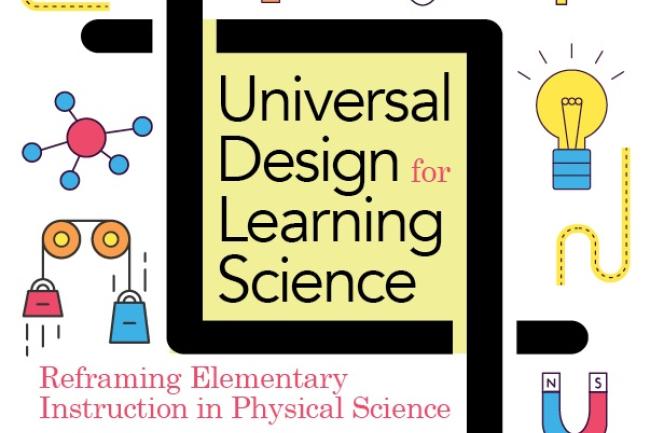Universal Design for Learning

According to Debi Hanuscin, one of the book's authors, “‘Universal Design for Learning Science’ is a framework for planning instruction to meet the needs of all learners by reducing different barriers. This design actually meets the needs of all different kinds of barriers that people might encounter, but it also works for you and me. It benefits everybody.”
Read more about the book
Whether you are student or an instructor, you have probably struggled with or watched other students struggle with basic lesson plans that are not inclusive to everyone’s learning styles. In collaboration with University of Missouri professor Delinda van Garderen, WWU professor Debi Hanuscin has written a book, “Universal Design for Learning Science,” or UDLS.
Their book features the 5E Learning Cycle, which explains how to apply inclusion practices in your classroom as a science educator. The 5E framework is based on five terms: Engage, Explore, Explain, Extend and Evaluate. Hanuscin’s reiteration of the 5E Learning Cycle shows instructors how to cohesively apply these frameworks when teaching science.
The book incorporates misconceptions that instructors have encountered with the many versions of the Learning Cycle. Also included in the book are vignettes written by science educators who have learned and applied these frameworks in their classrooms. The book finishes with instructions on how to personally apply the frameworks in your own classroom.
Hanuscin said, “‘Universal Design for Learning Science’ is a framework for planning instruction to meet the needs of all learners by reducing different barriers. This design actually meets the needs of all different kinds of barriers that people might encounter, but it also works for you and me. It benefits everybody.”
The barriers that Hanuscin referenced are “learning disabilities, autism, emotional or behavioral disorders, or intellectual disabilities; English language learners; or learners who come from culturally and linguistically diverse backgrounds.”
Van Garderen’s hope for the book is that it will be read and put into practice by professional educators. “I am hoping all elementary and special education teachers read this and that it may get used in professional learning communities and college teacher education classes,” she said.
The development of these inclusion practices started with a professional development program created by Hanuscin and van Garderen called the QuEST program. The two professors worked for over 10 years together developing the program and facilitated it for two years with elementary educators in Missouri.
Hanuscin said, “I talked Delinda into writing a grant with me to run a professional development program. We worked with elementary teachers all over the state and provided workshops for them.”
Hanuscin continued, “We were able to help prepare teachers to teach science in ways that made it accessible to all the learners in their classrooms. So the book basically summarizes what we taught in that program but through the eyes of the classroom teachers that we worked with.”
The two co-authors hosted writing retreats for their collaborators to write vignettes and give input on how they implemented lessons in their classrooms and how that met the needs of their students. Hanuscin said many teachers were hesitant because they had never written a book before.
One of those teachers is Cody Sanders. Sanders was an attendee of the QuEST program and is in his third year of teaching fifth grade in Missouri.
“I am heavily using that 5E model and framework in my daily teaching of science as well as other subject areas that include open questioning,” Sanders said.
“As teachers, we want to be learners. So, as new research-based practices come out, most people are open to them and really embrace those new challenges because we’re ever-evolving, just like our students,” Sanders said.
Emily Borda, the director of Western’s Science Math and Technology Education department (SMATE), has a background in teaching both pre-service chemistry and physics teachers and undergraduate chemistry students. Borda has been an active member in many professional development programs dedicated to developing teaching practices and improving science content knowledge.
“All of the projects I’ve been involved in for K-12 have had a component about science content learning and another component about pedagogy,” Borda said.
As a facilitator of Western’s own professional development programs, Borda said, “We’re taking equity and inclusion as a bigger lens with which we’re looking through to think about things like active learning, formative assessment and mindset.”
Borda has been jointly appointed between chemistry and SMATE for 15 years. Both Hanuscin and Borda believe science is interdisciplinary in nature as Hanuscin is also jointly appointed within SMATE. Hanuscin is jointly appointed as a professor in Western’s College of Science and Engineering (CSE) and Woodring’s elementary education department.
Hanuscin said, “I have known since I was 8 years old that I was going to be a teacher. I was a cocky little kid, and I remember sitting in my class looking at my peers who were struggling, and thinking, ‘If the teacher tried explaining it this way maybe they would get it.’”
This is not Hanuscin’s first published work. She has co-authored and edited two other books and written eight separate book chapters. Hanuscin’s curriculum vitae includes nearly six pages of published works that she has collaborated on. Currently, UDLS is set to be published in early April of 2020, just in time for the National Science Teaching Association conference.
by Sophia Beach